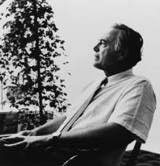 Image via Wikipedia
Image via Wikipedia
He started his own practice in Chicago in 1947. While unmistakably a modernist, Weese introduced richer detailing and materials than were commonly employed in most modern buildings. This came from his personal association with Aalto and with Saarinen, and, maybe, his appreciation for historic buildings.
His father was a banker, and Weese maintained a profit-making practice throughout his career. (On a visit with Aalto, he got the franchise for Aalto's furniture in the Midwest. He opened a furniture shop in Chicago after the war, where this and other modern furniture was sold, Baldwin-Kingrey.) He liked the juxtaposition of architecture as an art and a business. A fascinating oral history of Weese's life and career is housed in the Chicago Architects Oral History Project. If you have to choose between reading Weese's oral history and reading this blog - go for the oral history. It has not only a fascinating account of the development of modern architecture, it's the personal perspective of one of the most accomplished practitioners. Here's an excerpt, an anecdote about Eero Saarinen during Weese's year at Cranbrook:
- Weese: Oh, yes, he was a great friend. In fact, when I was there that summer, Eero challenged me to a duel.
- Blum: What was that about?
- Weese: His first wife, Lily, was something of a character, a sculptor, was kind of after me. She insisted she wanted to do a portrait of my head, so I had to pose for her in her studio. That was the summer they declared the women's dormitory off limits.
- Blum: And there you were.
- Weese: Eero found me in a bronze urn at the end of Academy Road curled up with his wife-to-be. After he got me out of there, he challenged me to a duel, but I talked him out of it.
He spoke at our school, Texas at Arlington, while I was taking Martin's design studio in 1978. Rightly anticipating a large crowd, the lecture was held in the gym. Weese's elegant double-breasted gray jacket and navy trousers were rumpled from travel, and he seemed tired as the talk got underway. He walked about on the gym floor, mike in hand, and seemed to want to just get through the talk and find a place to sit. When the question-answer part came, though, he became animated and energized. There wasn't any doubt this was a guy who would find reserves of energy when he wanted to engage in something. His presence was also remarkable. He was visibly an accomplished and forceful personality, but without any hint of arrogance or condescention toward students. Shaking hands with him, he had the politician's ability to connect by looking you in the eye and clearly focusing on you to the exclusion of everything else that was going on.
Weese was one of two architects on the 8-member jury for the Vietnam Memorial design competition. Details are murky, but the politics and emotions surrounding the competition, and the eventual construction, presented almost every conceiveable obstacle to the successful execution of the design as originally intended.
This was a three-year struggle, and it's difficult to believe that Weese's influence didn't guide the eventual result to a significant degree. The winning entry, by then-student of architecture Maya Lin, was highly controversial. The stark monument was deemed inappropriate because it was "somber," "not uplifting," "focused on casualties without including survivors," and was the object of every opinion available to the imagination of millions of would-be critics.
Ross Perot was a leading opponent of the Maya Lin design, and opinion coalesced in two camps. One favored Maya Lin's design, the other insisted on adding a realistic statue and a flagpole at the joint of the two wings of the memorial. An eventual agreement was made to build the memorial with both Maya Lin's plan and the statue-with-flagpole addition dead center of the wall. However, behind-the-scenes maneuvers somehow resulted in the successful solution that is seen today.
- REPORT
of the
VIETNAM VETERANS MEMORIAL
DESIGN COMPETITION
The jury for the Vietnam Memorial Design Competition finds Entry
Number 1026 the finest and most appropriate of the 1420 entries
submitted. We recommend to the Vietnam Veterans Memorial Fund that
it be built on this site.
Of all the proposals submitted, this most clearly meets the spirit
and formal requirements of the program. It is contemplative and
reflective. It is superbly harmonious with its site, and yet frees
the visitors from the noise and traffic of the surrounding city.
Its open nature will encourage access in all occasions, at all hours,
without barriers. Its siting and materials are simple and forthright.
This memorial with its wall of names, becomes a place of quiet
reflection, and a tribute to those who served their nation in difficult
times. All who come here can find it a place of healing. This will
be a quiet memorial, one that achieves an excellent relationship with
both the Lincoln Memorial or Washington Monument, and relates the
visitor to them. It is uniquely horizontal, entering the earth
rather than piercing the sky.
This is very much a memorial of our own times, one that could not
have been achieved in another time and place. The designer has
created an eloquent place where the simple meeting of earth, sky and
remembered names contain messages for all who will know this place.
Agreed, 11:25 A.M., May 1, 1981
Pietro Belluschi rfi^fa
Grady Clay
Garrett Eckbo
Richard H. Hunt
Co stantino Nivo
James Rosati
Hideo Sasaki /4
Harry M. Weese
Weese's largest project was the DC Metro system. Along with the extraordinary
Metro, itself, considered the world's premiere transit system, the restoration of the historic Union Station was carried out by Weese's firm.
above, DC Metro
An informative essay on the design of the DC Metro.
below, Union Station, DC
below, Swissotel, Chicago


No comments:
Post a Comment